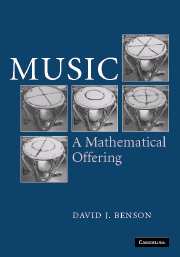Book contents
- Frontmatter
- Contents
- Preface
- Acknowledgements
- Introduction
- 1 Waves and harmonics
- 2 Fourier theory
- 3 A mathematician's guide to the orchestra
- 4 Consonance and dissonance
- 5 Scales and temperaments: the fivefold way
- 6 More scales and temperaments
- 7 Digital music
- 8 Synthesis
- 9 Symmetry in music
- Appendix A Bessel functions
- Appendix B Equal tempered scales
- Appendix C Frequency and MIDI chart
- Appendix D Intervals
- Appendix E Just, equal and meantone scales compared
- Appendix F Music theory
- Appendix G Recordings
- References
- Bibliography
- Index
5 - Scales and temperaments: the fivefold way
Published online by Cambridge University Press: 05 March 2013
- Frontmatter
- Contents
- Preface
- Acknowledgements
- Introduction
- 1 Waves and harmonics
- 2 Fourier theory
- 3 A mathematician's guide to the orchestra
- 4 Consonance and dissonance
- 5 Scales and temperaments: the fivefold way
- 6 More scales and temperaments
- 7 Digital music
- 8 Synthesis
- 9 Symmetry in music
- Appendix A Bessel functions
- Appendix B Equal tempered scales
- Appendix C Frequency and MIDI chart
- Appendix D Intervals
- Appendix E Just, equal and meantone scales compared
- Appendix F Music theory
- Appendix G Recordings
- References
- Bibliography
- Index
Summary
A perfect fourth? cries Tom. Whoe'er gave birth
To such a riddle, should stick or fiddle
On his numbskull ring until he sing
A scale of perfect fourths from end to end.
Was ever such a noddy? Why, almost everybody
Knows that not e'en one thing perfect is on earth–
How then can we expect to find a perfect fourth?
Musical World, 1863. Quoted in Nicolas Slonimsky's Book of Musical Anecdotes, reprinted by Schirmer, 1998, p. 299.Introduction
We saw in the last chapter that for notes played on conventional instruments, where partials occur at integer multiples of the fundamental frequency, intervals corresponding to frequency ratios expressable as a ratio of small integers are favoured as consonant. In this chapter, we investigate how this gives rise to the scales and temperaments found in the history of western music.
Scales based around the octave are categorized by Barbour (1951) into five broad groups: Pythagorean, just, meantone, equal, and irregular systems. The title of this chapter refers to this fivefold classification, as well as to the use of the first five harmonics as the starting point for the development of scales. We shall try to indicate where these five types of scales come from.
In Chapter 6 we shall discuss further developments in the theory of scales and temperaments, and in particular, we shall study some scales which are not based around the interval of an octave. These are the Bohlen–Pierce scale, and the scales of Wendy Carlos.
- Type
- Chapter
- Information
- Music: A Mathematical Offering , pp. 161 - 209Publisher: Cambridge University PressPrint publication year: 2006



